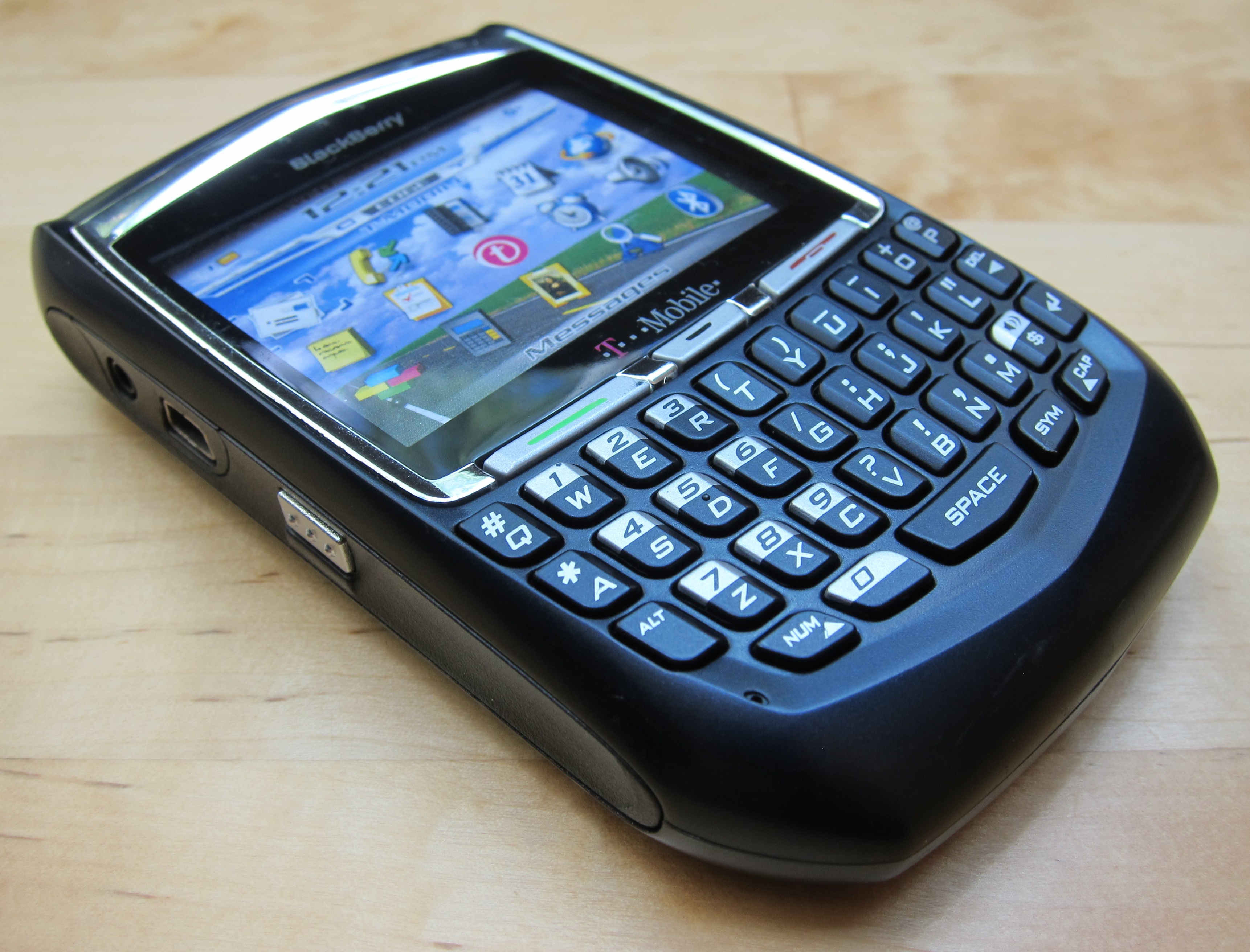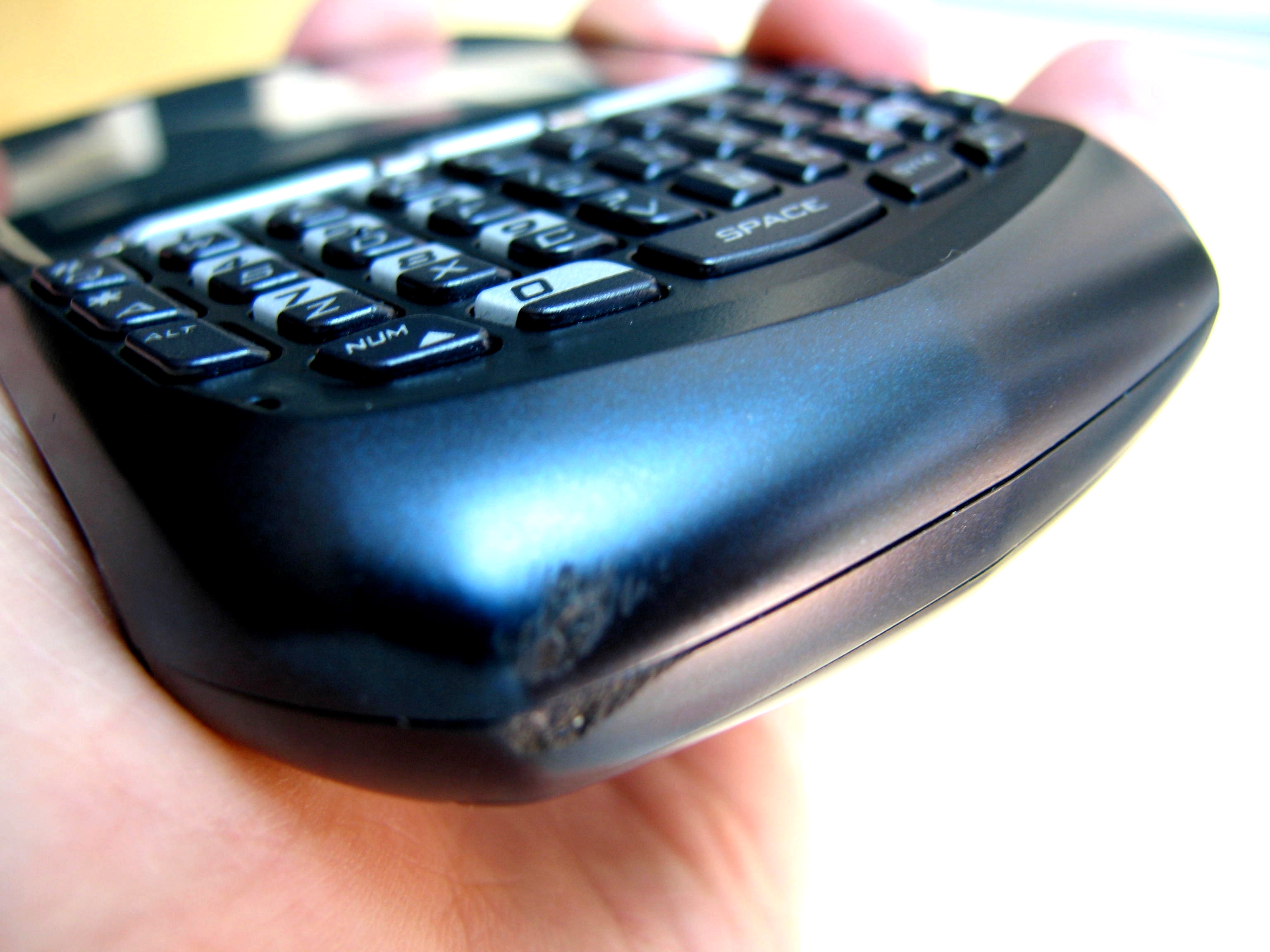Still stinging from the thousand bucks I dropped on my HTC TyTN I turned to eBay for a deal, and managed to find a local seller with an 8700g. It had branding from a carrier in the UK but the radio had been unlocked for use in Canada. I was unsure if the second lock on the device — the BlackBerry PIN — had been cleared, but all fears were allayed when I got the device, powered it up and successfully registered it for BlackBerry Internet Service (BIS).
In many ways, BlackBerries are win-win for carrier and user alike. Just like Danger’s hiptop, BlackBerry data passes through a central server before arriving on your handset. For carriers, this means less congestion on their networks; for users it means faster data — at least it did back in the dark days before the widespread availability of 3G. The BlackBerry operating system had a particularly helpful feature wherein the user could send “service books” to their device. If your email wasn’t working or some other ailment had besieged your handset a binary blob would be sent down the pipe to save the day. I’ve never seen this feature on any other mobile OS.
Though made almost entirely of plastic my CrackBerry was tough as nails; it shrugged off a brutal drop from about chest-high to an unforgiving sidewalk. Chalk this up to its roots as a text-only pager, I guess… And for text-related activities the BlackBerry did very well. Despite the fairly hideous on-screen fonts, dealing with email from multiple accounts was a breeze. Another BlackBerry innovation was the global inbox, a central dumping ground for incoming email, text messages, even missed calls. RIM has since removed SMS from the global inbox by default, which has been a challenge for my older siblings who still don’t entirely get what a text message is, let alone how to send one.
Sadly, any hopes of a CrackBerry addiction for yours truly were vanquished in short order by an absolutely reprehensible app called PocketMac, which RIM licensed as the official syncing software for Apple desktop computers. It routinely ate appointments, contacts and/or to-do items on every sync, and it was a constant game of cat and mouse to suss out what had gone missing. Thankfully OS X now has a proper Desktop Manager, but I’m a proper Linux user now. And to be brutally honest, I don’t think BlackBerry’s proxied Internet is of much use in a world where 3G data is cheap and plentiful. Well, plentiful anyway.
I did use a borrowed BlackBerry Curve many years later on vacation in Bermuda. It was the only way I could get an unlimited data package from the local carrier there. The BlackBerry experience in 2011 wasn’t enough to win me back, but the on-screen fonts were better, at least.
]]>
Just like this dummy model I got the non-souvenir, working version of the BlackBerry 8700g via an eBay auction. Mine was made for the UK carrier O2, but all versions of the “Electron” series shared identical specs — quad-band GSM, no camera, great keypad, scrollwheel on the side… The 8700 line had already been on sale for about a year when I started using it in April of 2007, so I was able to test my CrackBerry addiction for a song.
Email was great, the browser seemed okay and BlackBerry Maps was an unexpected treat. But for me the CrackBerry fell flat on its face with PocketMac, the then “official” syncing software for Apple desktop computers. It may be better now, but when I used it PocketMac would eat random appointments, contacts and/or tasks on every sync — far too high a price to pay even for free software.
My CrackBerry also, quite literally, fell on its chin from about waist-high to an unforgiving sidewalk. Some folks quite like having battle scars on their gear; not me, though — I’m vain that way.
If you’d like to read more about my BlackBerry experience I posted three separate entries about it on my personal blog.
]]>The original hiptop didn’t even have a camera; for tiny, blurry photos you had to buy a separate accessory that plugged into (of all things) the headset jack. But its innovative design provided ample room for a near-perfect qwerty keypad. They might well have called this phone the fliptop, as the keys were hidden beneath the screen until needed. To access them you’d simply flip the screen panel out — a combination of magnets and a sturdy hinge would make it pivot a full one hundred and eighty degrees, snapping into the open position with a satisfying click. It never failed to impress, myself included.
The second generation hiptop2 added a built-in 320×240 pixel camera with flash, still fixed-focus and well behind the times but better than nothing. Amazingly, the flip-out screen now sat flush with the rest of the phone when closed; this meant that the keypad was set in a bit deeper than before, but no matter — it was still a joy to use. And navigating the Danger OS was a breeze thanks to four humongous buttons surrounding the screen. Plus a scrollwheel. Plus a four-way directional pad that doubled as the earpiece, of all things!
As great as the hardware was, it wasn’t the hiptop’s stand-out feature. Like BlackBerry’s Internet Service, data on all hiptops was routed through a central server to optimize bandwidth and ease congestion on carriers’ networks. But unlike BlackBerry, Danger’s solution offered two significant advantages for the user. The first was unlimited data — that’s right, all you could eat for a mere twenty Canadian dollars per month. Web browsing, emails with attachments, instant messages… didn’t matter what it was, it was all included. So long as you weren’t roaming internationally you’d never have to pay anything more than the standard monthly fee. Of course, when you were travelling the hiptop was a terrible choice. Data was an all-or-nothing proposition, a hard lesson I learned after racking up over two hundred dollars in roaming charges when I turned my hiptop2 data on over breakfast one morning in the UK.
The persistent Internet connection provided another benefit for hiptop users: with every device came a free web portal where personal data and emails were stored. You didn’t have to worry about syncing data to any one desktop computer; so long as that computer had a web browser you could access everything on your hiptop from there. The portal also featured a webmail client, and since hiptops supported multiple push email accounts you’d need never worry about BlackBerry envy.
The price for all this convenience was learned later, when it was time to get my data off of the hiptop servers. Danger sold a plug-in for Microsoft’s Outlook called Intellisync, which gave me a local copy of my address book on a Windows computer. Photos could be downloaded individually from the hiptop web portal, but calendar entries, notes and to-do items had to be transcribed by hand if I wanted to keep them. And I did.
Danger’s proxied data service was similar in another way to BlackBerry’s BIS: It went down a lot. It happened often enough to be a familiar pain, rendering the device all but useless except for phone calls and SMS. I would always know when the data service came back up; my hiptop would vibrate with a loud grunt as everything on it was restored.
Still, my hiptops were fantastic devices, right up there with the best smartphones I’ve ever had. My hiptop2 was dependable enough to survive two weeks in Uganda in 2005. Though I had no data there I found a way to post short dispatches to my blog via SMS. Part of that trip was a three-day journey to and from the Bwindi Impenetrable National Park to see gorillas in their natural habitat. I can still remember spotting the first cell tower on the long drive back, and firing up my hiptop to let the world know that I was still alive.
That same hiptop was memorable for another, more dubious achievement. It holds the first and so far only breakup text I’ve ever received. Ouch.
]]>